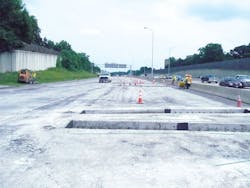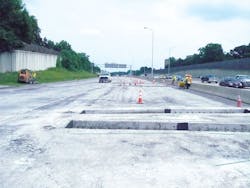Best of both worlds
Historically, pavement engineers have strived to balance safety and driver comfort when designing long-lasting concrete pavements.
In recent years tire/pavement noise has become a hot-button issue for motorists and residents living near high-volume roadways alike. In the past this was a dilemma, since many of the more aggressive concrete surfaces that provided the best traction and safe driving also brought the unintended consequence of increased tire/pavement noise. Times have changed. With a new Next Generation Concrete Surface (NGCS), the I-394 rehab project in Minneapolis demonstrates departments of transportation now can have both.
For years, the Minnesota Department of Transportation (MnDOT) fielded public concerns over the din created by cars traveling across I-394. Now, with a new NGCS in place, residents of the Bryn Mawr neighborhood near downtown Minneapolis will experience a long-lasting, significant reduction in tire/pavement noise. Motorists driving along this busy metropolitan section also will enjoy a quieter ride. But the new pavement surface is designed with safety in mind. The first new concrete pavement surface developed in the last 30 years, the NGCS solution combines a quiet ride with a safer pavement.
A noisy history
The circa 1988 section of I-394—from Highway 100 to I-94 in Golden Valley and Minneapolis—was originally constructed with a transversely tined concrete surface. A transverse tined surface is constructed perpendicular to the direction the tires travel along the surface. This orientation provides significant friction and reduces the chance of hydroplaning, but transverse tining is noisy. A standard practice at the time of I-394’s construction, transverse tining has been discontinued today by most transportation authorities in the U.S.
Complaints from residents related to I-394’s noise eventually reached the Minnesota State Legislature, which in turn passed legislation mandating that the surface be overlaid with asphalt to lessen the noise. In 1996, MnDOT applied the first of two asphalt overlays to I-394, while the structural condition of the original concrete was still of high quality. Noise was reduced, but only temporarily.
As the harsh Minnesota winters descended with their customary force, performance issues arose in the pavement. During freeze-thaw cycles, asphalt and concrete expand and contract at different rates. Over time, the different rates of expansion caused I-394’s asphalt overlay to crack, exposing the concrete joints underneath. The overlay began to delaminate in these areas and large potholes formed.
Eight years after the first overlay, the deteriorating surface was replaced in 2004 with another bituminous overlay.
“At that time, MnDOT did consider removing the asphalt overlay and diamond grinding the concrete to mitigate the noise,” said Matt Zeller, executive director of the Concrete Paving Association of Minnesota. “MnDOT discussed the options with the surrounding neighborhoods, but due to their unfamiliarity with the diamond-ground concrete surface, residents chose to stick with the perpetual mill-and-overlay solution for noise mitigation, even if that surface would not last as long as a concrete surface.”
Repair solutions
In 2014, MnDOT once again needed to rehab I-394. Repair solutions came in the form of two concrete pavement strategies gaining national momentum: the “buried treasure” preservation concept and NGCS.
The buried treasure preservation concept is a procedure used to recover an otherwise structurally sound concrete pavement that was overlaid due to functional deficiencies such as excessive noise or poor ride. To implement the buried treasure concept, crews remove the aging asphalt overlay placed atop the concrete roadway followed by the installation of a low-noise surface finish on the newly exposed concrete. Because the underlying concrete on I-394 was now 27 years old and in need of some limited repair, the buried treasure concept provided an ideal solution, allowing MnDOT to address the root cause of the deterioration rather than simply cover it up.
The NGCS was conceived by the industry while working with Purdue University between 2006 and 2008 and fully developed at MnDOT’s MnROAD pavement test track. It represents the quietest non-porous concrete surface developed to date and is the first new concrete pavement texture introduced in the last 30 years.
A hybrid texture, the NGCS resembles a combination of diamond grinding and longitudinal grooving. The texture is most easily constructed in a two-pass operation using diamond-tipped saw blades mounted on conventional diamond-grinding and grooving equipment. The NGCS’ diamond saw-cut surface provides a consistent profile that is absent positive or upward texture, resulting in a uniform land-profile design with a predominantly negative texture. Testing has shown that these textures can be used for both new construction and rehabilitation of existing surfaces.
The result is a dramatic decrease in noise. A high-traffic freeway with a transversely tined surface can experience a 50% decrease in tire/pavement noise by applying the NGCS, according to the International Grooving & Grinding Association (IGGA). This represents a considerable benefit for areas with a greater need for quieter roads, such as urban or residential areas.
Recognizing the need for quieter pavements, a vast partnership that included the IGGA, American Concrete Pavement Association (ACPA), Portland Cement Association (PCA) and Purdue University developed the NGCS at Purdue’s Herrick Laboratories in West Lafayette, Ind., where research was conducted using its Tire Pavement Test Apparatus (TPTA), which can test nearly any pavement texture.
Test findings indicated the geometric configuration of the blades and spacers used to construct diamond-ground textures was not the controlling factor in noise generation; rather, the resulting fin profile was the most important factor. Producing a low-noise, diamond-ground surface required creating uniform and consistent land profiles. The research findings led to the NGCS solution for pavements. Following the research phase, proof of concept occurred at the MnRoads Low-Volume Road Facility.
Scope of work
The $13 million I-394 rehab included removing the existing asphalt overlay, assessing and repairing the exposed concrete, and constructing the new NGCS diamond-ground surface.
First, crews milled off the existing asphalt overlay. Deteriorated areas of concrete were removed and repaired where needed, with work including both full- and partial-depth repairs. Once concrete repairs were complete, the surface was retextured using the NGCS and all repaired areas had joints resealed.
Work began in June 2015 and was completed by November 2015. MnDOT took steps to complete the project as quickly as possible. Asphalt milling took place during night non-peak hours. When concrete repair work began, MnDOT closed westbound lanes for two weeks, using reversible HOV lanes to accommodate westbound traffic while crews worked around the clock. The process was repeated during a second two-week period to repair eastbound lanes. The weekday lane closures allowed for a more rapid completion than weekend-only closures. All of the NGCS grinding was performed during night non-peak hours to minimize the impact to the traveling public.
Like any major rehab project in a big city, safety and logistics were top priorities on I-394. Concrete barriers separated the crews from traffic to keep workers as safe as possible. In addition, managing the logistics of crews and equipment on a busy metropolitan interstate is critical. Crews and equipment must be safely moved on and off the jobsite, while old material is hauled off for recycling—all while creating minimal disruption to the traveling public.
In addition to I-394, the project included constructing a new deck for the Lyndale Avenue Bridge over Dunwoody Boulevard; Wayzata Boulevard improvements; enhanced bike and pedestrian lanes; and guardrail maintenance.
Compromised asphalt overlay was removed, allowing crews to address the underlying deficiences in the concrete on I-394—in some areas performing a full-depth excision and repair.
Noise testing
A research team from the MnDOT Office of Materials and Road Research conducted On-Board Sound Intensity (OBSI) measurements both before and after construction, and found a significant improvement in noise levels as a result of the NGCS. The initial (pre-grind) measurement took place on April 18, 2015, and the second (post-grind) measurement took place on Oct. 25, 2015.
Tests were performed in accordance with AASHTO specification TP 76-11, “Measurement of Tire/Pavement Noise Using the On-Board Sound Intensity (OBSI) Method,” with a pair of vertically oriented microphones affixed to the vehicle and positioned near the pavement/tire contact patch. In OBSI testing, the microphones are attuned to pavement noise and are not influenced by surrounding sounds. Road noise during the I-394 testing, which took place at speeds of 60 mph per AASHTO specification, was recorded and analyzed.
OBSI test measurements indicated that the NGCS resulted in a 56% tire/pavement noise reduction from the pre-existing asphalt wearing course and a 24% reduction in tire/pavement noise from the pre-ground transverse tine. Measurements showed an overall reduction of 47% in the contiguous 14 segments into which the project was split for the convenience of the test.
Jerry Geib, Research Operations Engineer at MnDOT, summed it up with concision: “When you do not hear any noise, you are on the NGCS.”
The buried treasure work on I-394 provides a cost-effective solution for MnDOT to repair the pavement and reduce noise. For this vital artery in Minneapolis, structural integrity is maintained, and with the NGCS solution in place, I-394 is expected to live another 20 to 30 years in peace and quiet. R&B
A pleased populous
Residents of the Bryn Mawr neighborhood near downtown Minneapolis have had an interest in seeing I-394’s noise issues resolved since the 1980s. Recent feedback from residents indicated that the new NGCS solution is at last offering them quieter pavement.
“It’s absolutely quieter, a lot quieter,” said Rick Standish, who lives immediately adjacent to I-394.
Kevin Thompson, president of the Bryn Mawr Neighborhood Association, said, “I enjoy driving on it. It seems smoother and sounds quieter.”
“I honestly would have to say I was expecting it to be quieter and I really think it is. I’ve really been listening,” said Dennie Juillerat, a board member of the Bryn Mawr Neighborhood Association. Juillerat lives immediately north of I-394.
Leo Verrett, whose house is farther from the highway but who drives on the road regularly, said, ”When we were driving from downtown Minneapolis and got onto the new section, there was a noticeable difference inside the car. It was a lot quieter.”
Bryn Mawr residents utilize Nextdoor, a social media site that offers a private discussion forum for individual neighborhoods. Comments on a discussion thread there included the following:
“I love driving home from the west end on I-394. Feels like driving on silk. Smooth and quiet.”
“We live [just north] of I-394, and I think it’s quieter not only to drive on, but the road noise we hear at our house seems to be less, too. Tell them [the Concrete Paving Association of Minnesota] thanks!”
Christopher Etz, who also lives next to the highway corridor, agreed with his neighbors, stating, “I will second what others around here are saying: Driving on it is a pleasure.”

